|
Introduction
Traditional Scottish music is rich and varied. Scottish music
includes music for fiddles, (violins) accordions, clarsach (a small
harp), bagpipes, Ceilidh bands, or Scottish Dance Bands, and of
course, vocal music. This unit examines different kinds of Scottish
music under the following headings:
Instrumental Music: Scottish Dance Bands; Clarsach; Bagpipes; and
Vocal Music: Waulking Song; Bothy Ballad; Classic Ballad; Lullaby;
Mouth Music.
Instrumental Music
Scottish Dance Bands
The Terms Scottish Dance Bands and Ceilidh Bands are often used
interchangeably. Traditionally, the word 'ceilidh' (pronounced
kaylee) described an evening consisting of music, singing, piping,
dancing, and whatever else was available on the occasion, but
nowadays the term is often used to mean an evening of Scottish music
and dancing.
These bands commonly consist of three to five musicians,
playing such instruments as accordion, fiddle, piano, double bass and
drums. Some modern ceilidh bands include guitars, flute, whistle and
other instruments. Often there is a dance 'caller' who briefly
instructs the guests in each dance. Sometimes the caller is a band
musician, sometimes a separate dance caller/Master of Ceremonies is
used, depending on the band and the occasion.
Popular dances include The Dashing White Sergeant, Strip the
Willow, Waltzes, The Gay Gordons, Eightsome Reel etc. and the
music used for these dances are usually traditional Scottish Dance
Tunes such as reels, strathspeys, jigs and waltzes.
Reels
One of the oldest types of Scots dance is a reel. Reels are also
found in English, Irish and American folk music. Characteristically,
reels are often 16 bars long and are in two sections. Music in two
sections is often called binary form and the sections are described
as section A and section B - or AB form. Each section in a reel is
usually repeated (described as AA, BB) and often several reels are
played one after the other to create a longer dance. They are usually
played at a fairly fast tempo.
Click  to
listen to the example of a reel called Soldier's Joy. to
listen to the example of a reel called Soldier's Joy.
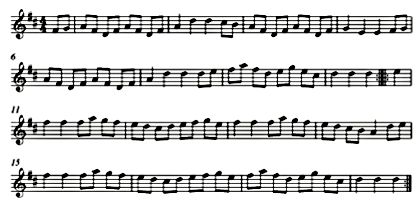
Strathspey
The strathspey is one of the most distinctive kinds of Scottish
music as it frequently uses dotted rhythms, both  and and  .
The second of these rhythms is very characteristic of Scottish music
and is known as a 'Scots Snap'. Strathspeys are usually played slower
than reels but usually have 4 beats to the bar. They are also usually
in binary form. .
The second of these rhythms is very characteristic of Scottish music
and is known as a 'Scots Snap'. Strathspeys are usually played slower
than reels but usually have 4 beats to the bar. They are also usually
in binary form.
Click  to
listen to the strathspey Brochan Loch printed below and see
if you can identify the 'Scots Snaps' in this piece. to
listen to the strathspey Brochan Loch printed below and see
if you can identify the 'Scots Snaps' in this piece.
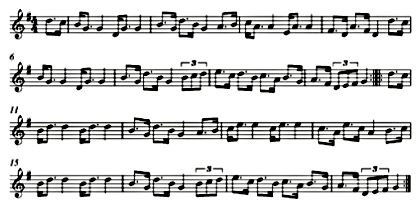
Jig
The jig is a dance shared by Scottish and Irish traditions alike.
Jigs are often written in either 6/8 or 9/8 and are quite fast.
Click  to
hear the popular Scottish Jig called Haste to the Wedding. to
hear the popular Scottish Jig called Haste to the Wedding.
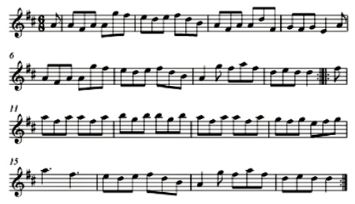
Waltz
The waltz is not native to Scotland and was brought to Britain
from Europe in the 19th Century. The time signature of a waltz is
usually 3 /4. A Scottish waltz is simply a waltz danced to a
set of Scottish tunes or songs, which have 3 beats to a bar. Waltzes
are often in ternary form, which means music in 3 sections, the 3rd
section being a repetition of the 1st section. Using letters this
would be described as ABA form.
Westering Home, printed below is a very popular Scottish
song about somebody travelling home to the island of Islay, off the
West Coast of Scotland.
Click  to
hear Westering Home to
hear Westering Home
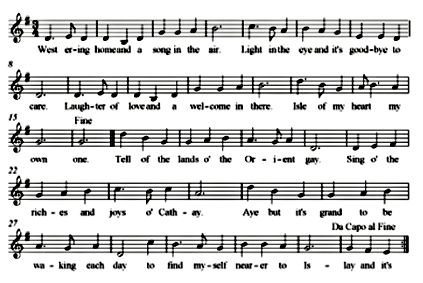
Clarsach
The clarsach is a Scottish folk harp with a very pleasant and
quite plaintive sound. The clarsach is smaller than the concert harp
and is ideal for delicate music for small functions, receptions and
dinners. The 'clarsair' (the person who plays the clarsach) sits on a
low stool with the harp held between the knees. The instrument
usually has about thirty gut or metal strings.
Pipe Bands
Pipe bands can still be heard in many Scottish towns today. Pipe
bands consist of pipes and drums and usually play a repertoire that
includes marches, strathspeys and reels.
Pibroch
The word pibroch comes from the Gaelic, "piobaireachd",
meaning pipering. Pibroch is sometimes described as the classical
music of the Highland Bagpipe. The pibroch repertory includes
official Salutes, Laments and Gatherings, all composed in theme and
variation form, or A, A1, A2, A3, A4, A5 A6 etc.
Listen to the pibroch piece The MacGregor's Gathering, also
known as the MacGregor's Salute, which is the ceremonial
rallying tune of the MacGregor clan.
Click  to
download an MP3 of High Road To Gairloch performed by Peter Draper. to
download an MP3 of High Road To Gairloch performed by Peter Draper.
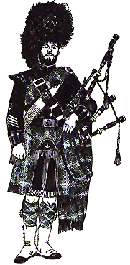
Vocal Music
Waulking Song
People in every culture around the world have used music to help
them in their work, especially work involving a lot of physical
effort. A typical example in today's society is the use of fast music
played in many gyms to encourage people to work out more
energetically! You may have heard of rowing songs; song used to help
people maintain a steady beat when rowing a boat. In Scotland, work
songs often accompanied manual tasks.
The term 'waulking' refers to the practice of shrinking tweed. The
waulking of the cloth was done by soaking it, then beating it with
feet or hands until it would shrink, making the tweed much stronger
and more waterproof. The work often took place on a waulking board on
which a number of women were seated. The length of cloth was then
pounded on the board by stamping on it. This method of shrinking
cloth passed out of use in the Hebrides around the time of the Second
world War and the songs are now sung at ceilidhs.
'Waulking songs', therefore are songs which were sung to help with
the physical exertion of 'waulking the tweed'. The lyrics often
concerned husbands, sweethearts or heroes and the verses were often
improvised with a traditional refrain (or chorus) which often
contains words such as "hi ri o etc".
Here is an example of a working song called Tha Mulad. The
song is in Gaelic but an English translation is shown. Can you
identify the Scots Snaps?
Click  to
hear Tha Mulad to
hear Tha Mulad
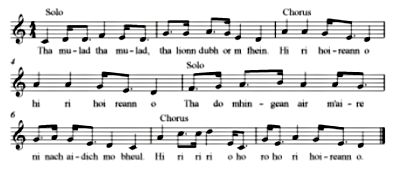
v.1 There is sadness, sadness
There is melancholy on me
Hi ri hoireann o, Hi ri hoireann
There is so much discontent on my mind
A thing that my mouth will not confess
Hi ri ri ri, o ho, ro ho ri hoireann o
v.2 About the fine youth
Young rider of steeds
About this time last year you
preferred my welcome before that of hundreds
v.3 I am no more to you this year than
The wild birds of the sky.
There is a heavy load in my heart
That the fiddle strings cannot lift.
v4. I wouldn't tell my sister
The greatness of my lamenting after you
Nor to the mother who bore me
I put a heaviness in her step. Etc....
Bothy Ballad
If you go into the countryside in many areas of Scotland, but
particularly the north-east of Scotland in Aberdeenshire, you may
come across several small buildings called 'bothies'. Nowadays these
buildings are used by hill-walkers to rest over night in when walking
the hills. They usually contain beds and other very basic facilities
and it does not cost anything to stay there. However, the buildings
were originally built to house farm labourers during the late 19th
and early 20th century as their work was often too far away from a
town to allow the workers to travel home for the evening.
Bothy workers often made their own entertainment, telling stories,
singing songs and playing musical instruments such as mouth organs
and fiddles. They also used to make up songs about the farms on which
they worked, girls they were courting and sometimes their employers.
These songs have become known as 'Bothy Ballads' and are now sung as
entertainment at ceilidhs and folk evenings.
The Bothy Ballad shown below is about a farm called Rhynie.
Click  to
hear this piece to
hear this piece

v.2 Rhynie's wark it's ill tae wark
Rhynie's wages is but sma'
An Rhynie's laws are double strict
A that does grive me warst of a'
v.3 Rhynie it's a caul' clay hole
It's far fae like ma faither's toun
An Rhynie it's a hungry place
It disna suit a Lowlan' loon
v.3 But sair I've wrocht an sair I've focht
And I hae won ma penny fee
An I'll gang bach the gate I cam
An a better bairnie I will be.
Explanation of some terms!
v.1'hairst' - harvest, meaning a young sheep first sheared at
harvest time
'fit o' Bennachie' - foot of the hill of that name in Aberdeenshire
'ill tae fit' - hard to please
'laith' - loath
v.2'wark' - work
v.3'toun' - ferm- toun, farm and it's buildings
'hungry' - mean, difficult'Lowlan' loon' - lad from the Lowlands
Classic Ballad
A classic ballad is a ballad that tells a story. The story
is told through a mixture of narrative and dialogue. We get to know
the different characters in the story and follow their fortunes as
events unfold. Ballads are often very long compared to other songs
and require sustained listening. Stanzas usually contain two or four
lines and there may be a refrain, which could be the last line of
each verse.
Click  to
listen to The Twa Brothers, which is an eerie tale about two stepbrothers. to
listen to The Twa Brothers, which is an eerie tale about two stepbrothers.

v.2 Said William to John "I cannot throw a stone
Nor little can I play at a ball
But if you come down tae yon merry green woods
I'll try a wrestlin' fall,
'll try a wrestlin' fall.
v.3 So they cam doon tae yon merry green woods
Beneath the spreading moon
And the little pen-knife slipped out of Williams pocket
And gave John his deadly wound
And gave John his deadly wound
v.4 "Oh you'll take off your white holland shirt
And tear it fae gore to gore
And you will bind my deadly wounds
And they will bleed no more
And they will bleed no more
v.5 So he took off his white holland shirt
And he tore it fae gore to gore
And he did bind his deadly wounds
But they bled ten times more an more
But they bled ten times more
v.6 "Oh what will I tell tae your sister dear
This night when I go home"
"You can tell her I'm away tae a London school
And the good books I'll bring home,
And the good books I'll bring home"
v.7 "An what will I tell tae your stepmother dear
This night when I go home?"
"You can tell her I'm dead and in graves laid
For she prayed I might never come home.
She prayed I might never come home."
Lullaby
Lullabies are sung in many different cultures. The words of
lullabies often concern a father or sweetheart, or may express the
mother's hopes for her child when it reaches adulthood. The majority
of lullabies are in 3 /4 time or 6 /8.
Click  to
listen to this lovely well-known Gaelic lullaby, which can also be
sung as a Christmas carol, as it is below. to
listen to this lovely well-known Gaelic lullaby, which can also be
sung as a Christmas carol, as it is below.
Click  to
listen to an MP3 of this sung by Karen Dow accompanied by Janice
Griffin on guitar. to
listen to an MP3 of this sung by Karen Dow accompanied by Janice
Griffin on guitar.
Click  to
download and listen to the last verse and chorus featuring a year 7 choir. to
download and listen to the last verse and chorus featuring a year 7 choir.

v.2 Your mild and gentle eyes proclaim
The loving heart with which
you came
A tender helpless tiny babe
With boundless gifts of Grace.
v.3 King of Kings, Most Holy One
God the Son, Eternal One
You are my God and helpless son
High Ruler of Mankind.
Mouth Music
When there were no instruments available, people often sang tunes
for dancing. This music is called 'Mouth Music'. In Gaelic society,
mouth music is called called 'puirt a beul' and is usually nowadays
only heard as listening music. The singers often sing dance tunes
with word in Gaelic. It is essential to keep the rhythmic pulse
constant when singing in order not to interrupt the flow of the dancers.
Another type of mouth music can be found in the Lowlands of
Scotland. One form of mouth music used is called 'diddling'. Popular
reels and jigs tunes are 'diddled' for the dancers and again it is
important not to interrupt the rhythmic flow when breathing, when
singing this kind of music
Acknowledgement to Jo Millar - Director of Scottish Music, Royal
Scottish Academy of Music and Drama.
Scottish Music Questions
Put the title 'Scottish Music' in your exercise books, then answer
the following questions in sentences.
1.Name four instruments commonly used in Scottish Music.
2.What was traditionally the meaning of the word 'ceilidh' and how
is the word often used now?
3.How many and which instruments could a Scottish Dance Band
commonly consist of?
4.Name four popular dances often danced at Ceilidhs.
5.Write four short paragraphs detailing the musical
characteristics of a Reel, a Strathspey, a Jig and a Waltz.
6.Write the term 'Scots Snap' in your exercise book and then draw
some notes that could be described as representing this rhythm.
7.Copy the following sentence, inserting the correct missing word:-
A _ _ _ _ _ _ _ is a Scottish folk harp with a very pleasant and
quite plaintive sound.
8.What kinds of music do pipe bands often play?
9.What word is sometimes used to describe the classical music of
the Highland bagpipes?
10.To what does the term 'waulking' refer?
11.What are 'Bothy Ballads'?
12.Describe a 'Classic Ballad'.
13.Name two time signatures that are often used for lullabies.
14.What do the words of lullabies often concern?
15.What was 'Mouth Music' originally composed for? Name two
types of mouth music.
Extra Task
Using the CD-ROM 'Musical Instruments', look up 3 instruments
commonly used in Scottish music. Read the information, listen to the
examples and draw and label the pictures.
|